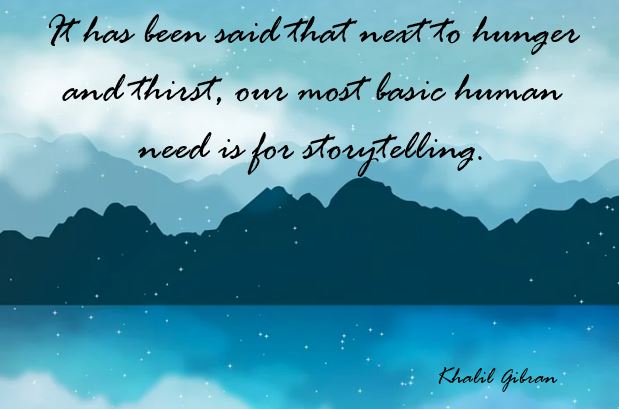The Magic of Storytelling
Written by Julie Bisnath, BSW RSW
Oral stories are powerful things—they can teach, entertain, evoke emotion, elicit memories, develop imagination, provoke deeper thinking, and prompt reflection. Most importantly though, they bring us together and keep us connected. Stories transcend time and space, have the power to evolve, and are free to give and receive. Pretty impressive if you ask me.

Storytelling is also very natural—we do it all the time without even thinking about it—when we recount an incident or event, when we reminisce, when we tell a joke, and when we use examples to teach or reinforce a moral or value. What’s more, is that oral storytelling—many stories existed well before the printed word—with children is universal. And for good reason! Oral stories are hugely important to a child’s cognitive and emotional development.
“Telling and listening to stories provides a bridge between the oral language skills of early childhood and the more formal language of print. With the ability to tell stories develops the ability to talk about things outside the here and now, to understand how we use language to express cause and effect and to talk about feelings and motivation.”
Did you know that by the time a child is 2 ½ years old they are usually familiar with the basic structure of storytelling? They know how to sequence basic events, understand the purpose of place and time, and can organize characters. Amazing! But why—and to what end? Telling stories helps children solve problems and work out concerns. Just as we might see them acting out a worry with dramatic play, children will tell stories (not necessarily to others) to help make meaning of an event or incident. Storytelling also plays a role in how children view and understand themselves within the context of their family, and their community.
We know that children express themselves in many ways. When we support the development and expression of communication in all of its forms, we are telling children that we see them as capable and competent.

What stories are being told here? Who are the storytellers and who are the story-listeners? Look at the connections and togetherness created during these moments.
So, what can we do to encourage storytelling in young children?
- Have lots of conversations using rich vocabulary and a variety of concepts
- Introduce and expose children to a wide variety of story mediums—written, oral, theatrical, etc. and story genres.
- Encourage storytelling and story-listening all throughout the day—mealtime, bath time, naptime, in the car, out for a walk…have children narrate stories about their play and about their art. If you can, transcribe their stories or take a video.
- Tell them stories about themselves, children love to be the central character in their own story!
- Practice re-telling a familiar story together—based on a real event or a popular tale.
- Use the tools of rhyme and repetition—children love hearing the same story over, and over, and over…!
- Ask open-ended questions: Who are the people in the story? What happens next?
- Model storytelling using various props. A felt board and felt shapes (take a look at Frosty Fun our new Winter Mini Felt Kit!), simple masks, a story apron, story stones or discs (check out our Wooden Wonder Collections!), all add to the storytelling and story-listening experience.
- Play with puppets—puppets no matter how simple, can provide a “third voice” (separate from the narrator and audience) adding to the dramatic interest. Puppets often have the freedom to say and do things that we might not, making them excellent teaching tools. Simple puppets might be as easy as using your bare hands. Other puppets might be made out of paper bags, paper and popsicle sticks, paper plates, photos, socks, fabric, etc. These can be made by an adult or child. More elaborate puppets can be purchased commercially. For a unique and beautiful addition to your storytelling tools consider one of CCPRN’s handmade story puppets (Coming Soon!)—crafted to include a puppet pocket and puppet accessories, these pieces are sure to inspire.
- Don’t forget to think about your tone of voice, volume, body language, and gestures. Using these effectively is what makes the story come alive.
- Invite the children to enjoy a story table, story basket, or story sensory bin: Using the script from a familiar picture book, children manipulate the materials to act out and re-tell their own version of the story.
- Try something new: cut and tell stories are fun and engaging! This one is simple yet captivating: http://drjeanandfriends.blogspot.com/2017/01/cut-and-tell-stories.html
- Introduce reflection with occasional comments: “Hmm, I wonder how that makes him feel?”, “I was thinking about that story you told earlier…”.
Most importantly, listen attentively and participate actively when a child tells you a story (even if you’ve heard it 50 times before!). Enjoy the beauty and magic of the moment.
References & Resources:
https://www.zerotothree.org/resources/1057-storytelling-in-the-first-three-years
https://www.scholastic.com/parents/school-success/learning-toolkit-blog/storytelling-children.html
https://speechtherapycentres.com/tell-me-a-story/
http://drjeanandfriends.blogspot.com/2017/01/cut-and-tell-stories.html
